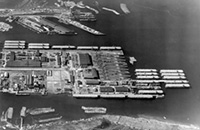Todd Shipyards Overview
Todd Shipyards Corp. is one of the oldest surviving shipbuilding companies in the United States. Its origins date back to 1916, and at one point it ran shipbuilding operations throughout the U.S.

Written by Aaron Munz • Edited By Walter Pacheco
Asbestos.com is the nation’s most trusted mesothelioma resource
The Mesothelioma Center at Asbestos.com has provided patients and their loved ones the most updated and reliable information on mesothelioma and asbestos exposure since 2006.
Our team of Patient Advocates includes a medical doctor, a registered nurse, health services administrators, veterans, VA-accredited Claims Agents, an oncology patient navigator and hospice care expert. Their combined expertise means we help any mesothelioma patient or loved one through every step of their cancer journey.
More than 30 contributors, including mesothelioma doctors, survivors, health care professionals and other experts, have peer-reviewed our website and written unique research-driven articles to ensure you get the highest-quality medical and health information.
About The Mesothelioma Center at Asbestos.com
- Assisting mesothelioma patients and their loved ones since 2006.
- Helps more than 50% of mesothelioma patients diagnosed annually in the U.S.
- A+ rating from the Better Business Bureau.
- 5-star reviewed mesothelioma and support organization.
Testimonials
My family has only the highest compliment for the assistance and support that we received from The Mesothelioma Center. This is a staff of compassionate and knowledgeable individuals who respect what your family is experiencing and who go the extra mile to make an unfortunate diagnosis less stressful. Information and assistance were provided by The Mesothelioma Center at no cost to our family.LashawnMesothelioma patient’s daughter
How to Cite Asbestos.com’s Article
APA
Munz, A. (2023, August 25). Todd Shipyards Overview. Asbestos.com. Retrieved April 24, 2024, from https://www.asbestos.com/shipyards/todd-shipyards/
MLA
Munz, Aaron. "Todd Shipyards Overview." Asbestos.com, 25 Aug 2023, https://www.asbestos.com/shipyards/todd-shipyards/.
Chicago
Munz, Aaron. "Todd Shipyards Overview." Asbestos.com. Last modified August 25, 2023. https://www.asbestos.com/shipyards/todd-shipyards/.
The company walked away from yards in New Orleans and Houston in 1989. It closed the Los Angeles location in 1989 as part of a cost reduction plan that included the relocation of its corporate office to New Jersey. The Galveston shipyard was shut down in 1991. The cost reduction came as the company’s shipbuilding projects had slowed down and claims related to asbestos exposure
Vigor Industrial bought Todd Shipyards for $130 million in 2010. It currently operates yards in San Francisco, Oakland and Brooklyn. The new owners instituted asbestos safety procedures to prevent exposure.
The International Journal of Environmental Health Research published a review in 2021. It presented a 2020 study on seafarers from five Nordic countries. They have more than double the risk of developing mesothelioma compared to the general public.
Todd Shipyards and Asbestos Lawsuits
Todd Shipyards has fought hundreds of asbestos claims. It has defended claims for mesothelioma, lung cancer and asbestosis.
Todd Pacific Shipyard settled many cases and has funds in reserve. It has insurance funds on hand for settlements. The company also defended claims brought by former employees at the Brooklyn Yard.
The Los Angeles location was also among those facilities at which former workers claimed asbestos was abundant. Former employee Sidney Osmundsen filed a mesothelioma claim against Todd in 1981. The case went to the U.S. Court of Appeals before he won.
The exposure at Todd Shipyards included minimal, moderate and high concentrations of asbestos.
According to a 2017 study published in the Archives of Environmental & Occupational Health, shipyard workers exposed to a moderate amount of asbestos were about four times more likely to die of mesothelioma. Workers exposed to high amounts were more than seven times more likely to get mesothelioma.

Oakland
Todd Pacific Shipyards bought the Oakland facility from United Shipbuilding in 1949. Workers there built and repaired small fishing boats and big oil tankers. Welders, construction crews and other employees were exposed to asbestos in high doses. Some employees reported that they stood in piles of asbestos as they worked.
The site resided in the famous San Francisco Bay near the Oakland Inner Harbor. The primary purpose of the Oakland facility was to serve as a repair station, as opposed to much of the major shipbuilding projects conducted across the bay in San Francisco.
San Francisco
The Todd Shipyards San Francisco Division started as a major ship construction facility near Alameda Point in the early 20th century. During World War I and the early 1920s, the facility expanded from seven acres to 75 and could carry out six construction projects at once. At the start of World War II, workers at the shipyards (now known as Bethlehem Alameda Shipyard) built transport ships and repaired over a thousand naval and civilian vessels for the war effort. It is currently part of Todd Pacific Shipyards, a subsidiary of Todd Shipyards.
As the shipyards expanded and construction projects continued, the facility increased its use of dangerous industrial substances, including asbestos. Up until the 1970s, asbestos was widely used in shipbuilding and construction projects. Many forms of insulation, including those used on pipes and electrical equipment, employed asbestos-containing materials to protect vital systems against overheating and fire damage. Asbestos fibers were also a main ingredient in gaskets and epoxies used to hold together crucial components.
Brooklyn
Todd Shipyards Brooklyn, also known as the New York Shipyards, began in the mid-19th century and as a repair facility for large shipping vessels. Workers there built warship and destroyers during World War II, but the shipyard closed in 1986.
Ikea, the Swedish furniture giant, bought the Brooklyn property and began tearing down the shipyard to construct a 35,000-square-foot store in 2006. Demolition was halted when asbestos was discovered in the former shipyard. It was not news to former shipyard workers there.
Los Angeles
Todd Shipyards began running the Los Angeles yards in 1943 when the U.S. Navy was dissatisfied with its own management of the site during World War II. This yard, then known as the San Pedro facility, became part of Todd Shipyards Corp. in 1945.







